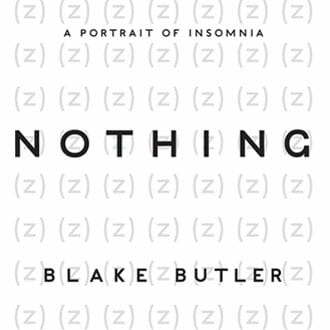Nothing: A Portrait of Insomnia by Blake Butler
Sleepless Nights From Thankless Thought

Insomnia plagues nearly 15 percent of adults. Blake Butler exists among this anguished set of sleep-deprived humans, battling a lifelong issue that he explores in this 2011 memoir.
The heralded Atlanta-based writer juxtaposes his personal recount with a history of sleep that is marked by facts and studies, all while reflecting on the dementia that currently grips his father’s mind. This manic, long-form essay of sorts echoes the headlong style of the late David Foster Wallace, to whom the book is dedicated.
“What those words inside me could have said, I wonder—where or what I would have gone or been today having them absorbed—somehow ending up another person— smarter, further—this, gone forever. And still, here I am. Now.”
As exhibited, Butler’s struggle for sleep occurs from fits of wandering thought, which he describes as “holes” and “thankless thinking.” One stream of rapid ideas, arguments, and memories follows another, then another, and so on. Night after night, he drowns in a sea of unending contemplations.
He writes: “Nothing is what keeps us waiting (forever).” This sentence further samples the writing style, with Butler rapidly spewing memories and examining facts in a superbly lyrical voice. In one spot, he brilliantly exemplifies the wandering-thought “holes” with an exhaustive six-page sentence of trivial thoughts, rants of self-hatred, facts and footnotes (clearly a nod to Wallace).
He begins with an introduction and a brief history on the subject of sleep. Then Butler takes us to his earliest memory of insomnia, touching on his adolescent habit of sleepwalking and on the nightly fear created by Stephen King’s horror blockbuster IT.
For me, it got personal. Page after page, with each new idea and recollection from different stages in Butler’s life, my own memories of battles with insomnia interrupted my reading. These experiences eerily parallel Butler’s … especially the catalogue of idiosyncrasies an insomniac requires to achieve security and comfort in bed: A particular pillow. A special blanket. Perfect position for the feet.
Butler states his awe for non-troubled sleepers, those people that close their eyes and so easily drift off into a wonderland of dreams. That’s true for this insomniac too. Staying over at a friend’s place or sharing a hotel room with pals, I listen without fail to my roommate peacefully find REM sleep. Meanwhile, I toss and turn in agonized envy, watching the hours drag past. The consummation of alcohol prior to bed may help, but it usually brings the booze-soaked rest Butler refers to as “shallow sleep.”
Nothing did nothing to help my sleeping issues. Reading about insomnia during evening hours made it completely impossible to reach the blank thought needed to drift out of consciousness. Several nights, I closed the book and furiously reflected on what I just read, analyzing myself. Butler’s examination of his restless thought and sleeplessness inadvertently infects his reader with the same tribulation. If he set out to keep people up with his book, he’s a genius.
Like many disorders, insomnia comes in flavors. My own falls primarily into the category of sleep-onset insomnia, a condition in which it takes longer than 30 minutes to get to sleep.
Insomnia can also be situational. As with many victims, including Butler, this condition torments a victim with sporadic waking throughout the night—clockwatching, thinking, checking the phone. While trolling Butler’s book for various forms of primary insomnia and secondary insomnia (sleep deprivation caused by psychiatric or medical factors), I found myself furiously misdiagnosing my own insomnia. Finally, I got a perfect match: sleep maintenance insomnia. That’s the ability to fall asleep but not stay asleep.
-

-

-

-

- Curated Home Page Articles By Test Admin October 21, 2025 | 3:10pm
-

- Curated Home Page Articles By Test Admin October 21, 2025 | 2:57pm
- Urls By Test Admin October 21, 2025 | 2:57pm
- Curated Home Page Articles By Test Admin October 21, 2025 | 2:55pm
-

-

-

-

-

-

-

-

-

-

-

-

-

-

-

-

-

-

-

-

-

-

-

-

-

-

-

-

-

-

-




































